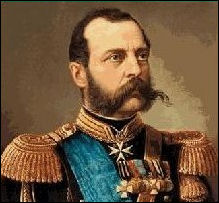TERROR, ANARCHISTS AND REVOLUTION IN THE 18TH AND 19TH CENTURIES
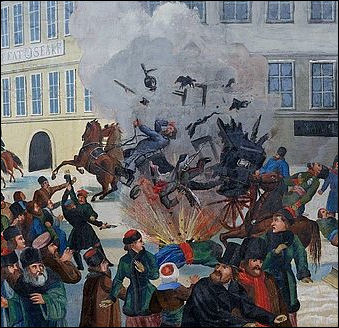
assassination of
Czar Alexander II in 1881 Early European groups that had similarities with modern terrorist groups include Russian nihilists, European anarchists, and Irish Fenians. Nineteenth-century anarchists carried out bombings and assassination campaigns but many scholars have argued that these were not really acts of terrorism in the modern sense because civilians were not the target.
“I have always dreamed”, says an anarchist in Joseph Conrad's novel “The Secret Agent”, “of a band of men absolute in their resolve to discard all scruples...No pity for anything on earth, including themselves, and death enlisted for good and all in the service of humanity.” But, Conrad's anarchist complains, “I could never get as many as three such men together.” [Source: The Economist, January 8, 2004]
The Economist reported: “From the mid-18th century, other groups launched suicidal attacks against colonial rulers in India, Indonesia and the Philippines. Then there are the countless individuals who have died for a cause without taking others with them: think of Irish and Kurdish hunger-strikers, or of the human minesweepers despatched by Iran during its war with Iraq.
Book: Blood and Rage: A Cultural History of Terrorism by Michael Burleigh (Harper/HarperCollins Publishers, 2009)
Robespierre and the Origins of Modern Terrorism After the French Revolution
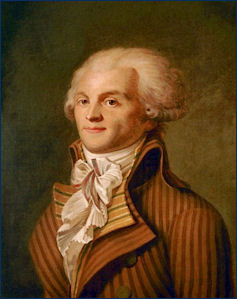
Robespierre The word terrorism comes from the Reign of Terror instigated in France by Maxmilien Robespierre in 1793, following the French Revolution. Robespierre, one of twelve heads of the new French revolutionary state, had enemies of the revolution killed, and installed a dictatorship to bring stability to France. He justified his brutal methods as evils necessary in France’s transition from a monarchy to a liberal democracy. Robespierre's ideas are at the root of of modern terrorist beliefs that violence is the best way to create a better system, and do it quickly. Among those influenced by his ideas were Narodnaya Volya, who hoped to end Tsarist rule in Russia in 1881 by assassinating the Russian tsar Alexander II. After Robespierre the idea of terrorism as a state action faded, while the notion of terrorism as an attack against an existing political order became more prominent.
Robespierre was the least charismatic but the best organized of the three main leaders of the newly-founded French revolutionary state (George Jacques Danton and Jean Paul Marat were the other two). Merle Severy wrote in National Geographic, "Slight, squeaky-voiced, prim and powdered, frugal, perfectionist, self-righteous, intolerant, sexually represses, Robespierre dresses like a gentleman, whose "de" he added to his signature when an idealistic young lawyer. As a boy, deprived or parental affection by death and desertion, he lavished loving care on sparrows and pigeons." [Source: Merle Severy, National Geographic, July 1989]
While Robespierre spoke out against mercenaries, pardons for the monarchy, slavery and capital punishment and endorsed the right to vote without property qualifications, he developed a repressive and ruthless system of government that relied on terror to meet their aims. Robespierre didn't attended the executions he ordered because he said they brutalized his character.
Reign of Terror
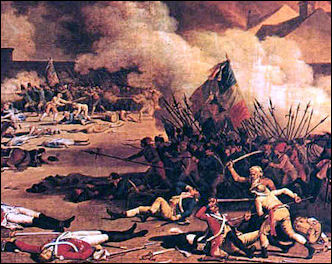
French Revolution in 1792 In June 1793, responding to counter-revolutionary activities in France and Austrian victories outside of France, a group of radicals called the Montagnards ("mountain dwellers," a reference to men that sit on the highest benches on the left side of the convention) took control of the Convention that ruled France at the time by purging a moderate faction.
The radical Jacobins — comprised mainly of few hundred members of the Parisian Jacobin club — were the core Montagnard group. They and moderate Girondists battled for control of the Convention, with Jacobins eventually arresting their rivals as traitors and seizing power. On June 2, 1993 the Paris Commune, allied with the Montagnards, burst in on the convention with Marat reading a list with the names of all 29 moderate leaders and demanding their arrest.
Danton, Marat and Robespierre were all Montagnards. They and nine other members established The Committee of Public Safety, governed by Robespierre, that introduced mass conscription, ruthlessly centralized the government, held secret meetings, used spies and informers and created a "Revolutionary tribunal" to deal with crimes against the state. The Committee of Public Safety has been compared with the Khmer Rouge and Robespieree has labeled as the original Pol Pot.
The Reign of Terror that followed the takeover of the Convention by the Montagnards was ushered in with a Festival of Unity in which blind children sang the "Hymn of Divinity," a chorus of 2,4000 parents and children chanted the "Hymn of the Supreme Being" and Robespierre gave a long speech on liberty and virtue. One young girl who was there wrote her father: "There were girls strewing flowers everywhere. My hair was simply full of them."
During the 11 month Reign of Terror 300,000 were arrested, 17,000 were executed, and another 35,000 perished in prison and summary executions. The majority of deaths took place in five of the nation's 86 departments. About 85 percent of all those who died were commoners. When it was over youth made fun of the terror by wearing red ribbons around their necks.
Compared to the multitudes that died in the religious wars of earlier centuries. The number killed in the Reign of Terror was relatively small.
Robespierre's New Religion and Death to the Impure
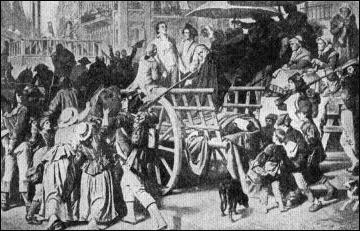
Reign of Terror Robespierre's cast himself as a sort of high priest of the revolution. He and his Jacobin disciples, such as the fanatical philosopher Saint-Just, promoted a new religion — the Cult of the Supreme Being based on Roman ideals and on the philosophies of Rousseau, whose works laid at his bedside.
The French were great admirers of Greco-Roman culture. Saint-Just, who some consider the architect of the Reign of Terror, imagined France as a modern Sparta of toga-clad warriors. He wrote "The Republic consists in the extermination of everything that opposes it."
At first the French Revolution was anti-military, rational, and legalistic. Saint Simon (1760-1825) advocated an orderly, just society directed by technocratic elite. But under Robespierre the revolution took a cruel turn in his pursuit of his dream of creating a Roussean utopia good men, uncorrupted by "aristocratic and ecclesiastic oppressors." and motivated by a bond of citizenship" rather than Christianity. Of his utopia Robespierre said, "its temple is the universe...it's religion virtue.”
In his attempt of make a perfect world Robespierre punished transgressors with "prompt, severe, and inflexible justice." Citizens are executed for being impure, for speaking against the terror, and standing up for those who spoke out. Prostitutes are rounded up as corrupterrs of Robespierre's republic of virtue." Towards the end of the reign the executioners themselves were executed for tyranny.
Severy, compared the radicals behind the Reign of Terror to “weasels thrust into a single cage” that “turn on each other and rip themselves apart.” Robespierre consolidates his power by imprisoning Danton and calling on the "sublime people" to finish the "half completed" revolution. "Happy is he who is born in your midst!" he said. "Even happier is he who can die for your happiness!"
Guillotines and Guillotine Victims
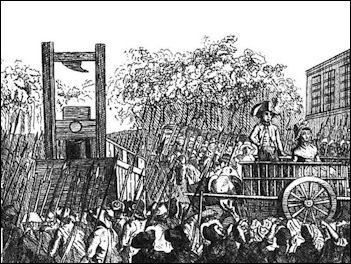
guillotine The guillotine was designed by Dr. Antoine Louis, a secretary of the French Surgical Academy, and constructed by Tobias Smith, a the German piano maker, but it was named after Joseph-Ignace Guillotin (1738-1814), a French doctor and member of the Revolutionary National Assembly who argued that the device was a "humane beheading machine" that could "whisk off your head in the wink of an eye, without your ever being aware of it" while sending a "cool breath on the back of the neck.”
Dr. Guillotine convinced the National Assembly to adopt the device over racks, wheels, swords, pincers, axes, ropes and medieval devices like "The Maiden." He argued it was an "inaffiable" machine that was more dignified than hanging (where victims often urinate and defecate in their pants as they die) and more "merciful than the sword (which sometimes requires several strokes to finish the job). Popular songs were written about the device and the doctor himself reportedly was nearly guillotined for protecting some aristocratic friends.
Dr. Guillotine suggested the use of the guillotine in October 1789. The devices were developed use in 1790 and first used in France in 1792 to execute a highwayman. The next year it was used to execute the queen, Marie Antoinette. Guillotines were still being used, albeit infrequently, in France up until 1981. They were also used in French colonies such as Vietnam. During the height of the Reign of Terror when the guillotines couldn't keep up the pace, masses of people were shot and pushed off barges while people looked on and cheered. Madame Tussaud got her start as a young wax artist who cast the death masks of guillotined heads.
The man who carried out Robespierre's "inflexible justice," was Antoine Fouquier-Tinville, a public prosecutor who made an effort to intercept the notes of the people he condemned so he could read them himself. Charles-Henri Sanson is listed in the Guinness Book of Records as the most experienced executioner. He dispatched 3,000 victims, most of them in 1793 and 1794. The Sanson family supplied several generations of executioners from 1688 to 1847.
Priests, aristocrats, shopkeepers, beggars, commoners and a general who lost a battle all died under the guillotine's blade. Women's rights activist Olympe de Gouges, the famous chemist Lavoisier and the poet André Chénier were all also executed. Counselor Dupin was 97 and Charles Dubost was 14 when their heads toppled off the block and at least one father died in the place of his son.
Some of "these criminals against the state" wept and prayed. Others cursed back or stood impassively. Madame du Barry, former royal mistress implored, "Save me friends...I beg you!" Danton was executed on April 5, 1794 partly for trying to bring about an end to the terror. When it was his turn he shouted "Show my head to the people. It's worth a look! Thomas Paine, the American author of “Common Sense”, also spoke out against the Reign of Terror and nearly lost his head for it.

Revolutionary Tribunals and Guillotine Executions
Revolutionary Tribunals issued the orders of execution during the Reign of Terror were set up as "the interpreters of the people's will.” Describing a Revolutionary Tribunal in Paris in October 1793, J. Millingen wrote, "In the centre of the hall, under a statue of justice, holding scales in one hand, and a sword in the other, with the book of laws by her side, sat Dumas, the President and the other judges. Under them were seated the public accuser...At the right were benches on which the accused were placed in several rows."
"Never can I forget the mournful appearance of these funeral processions to the place of execution. The march was opened by a detachment of mounted “gendarmes” — the carts followed; they were the same carts as those that are used in Paris for carrying wood; four boards were placed across them for seats, on each board sat two, and sometimes three victims; their hands were tied behind their backs, and the constant jolting of the cart made them nod their heads up and down, to the great amusement of the spectators."
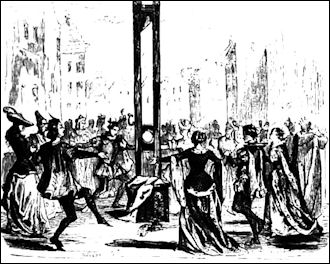
guillotine dance The condemned were brought to the gallows in tall, red horse drawn carts and along the way they were jeered and pelted with rotten fruit by crowds who lined the streets. "The process of the execution was also a sad and heart-rendering spectacle," Millingen wrote. "In the middle of the Place de Révolution was erected a guillotine, in front of a colossal statue of liberty...On one side of the scaffold was were drawn out a sufficient number of carts, with large baskets painted red to receive the heads and bodies of the victims. Those bearing the condemned moved on slowly to the foot of the guillotine."
"Most of these unfortunates ascended the scaffold with a determined step — many of them looked up firmly on the menacing instrument of death, beholding for the last time the rays of the glorious sun, beaming on the polished axe; and I have seen some young men actually dance a few steps before they were strapped to the perpendicular plane, which was then tilted to a horizontal plane in a moment, and ran on the grooves until the neck was secured and closed in by a moving board."
"When the head was passed through what was called in derision, “a lunnette républicoaane”; the weighty knife was then dropped with heavy fall; and, with incredible dexterity and rapidity, two executioners tossed the body into a basket, while another threw the head after it."
History of Beheadings
Steve Mufson wrote in the Washington Post: “From the headless corpses of North African warriors lined up before ancient Egypt's Temple of Horus about 5,000 years ago to Kim Sun Il, the South Korean interpreter killed in 2004 in Iraq, perhaps no method of execution arouses as much fear and revulsion as beheading. And usually that's just the effect its practitioners — whether monarchs or terrorists — want it to have. Beheading is the latest weapon in the hands of those who have sworn to punish Westerners, but it has a long history. It has been used from Medina to Manchuria, from Norway to Nigeria. [Source: Steve Mufson, Washington Post, July 4, 2004]
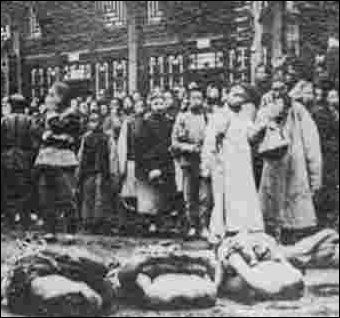
beheaded corpses in Caishikou, China “When U.S. citizen Paul Johnson was beheaded by terrorists in Saudi Arabia in 2004, six Saudi clerics issued a statement that said: "The bombings and killings have revolted people and hurt individuals and their property, and no one with the slightest knowledge of Islam can doubt that this is an atrocious crime and grave sin." But in their eyes, the sin was the improper taking of a life, not the method. The Saudi government beheaded 52 men and one woman last year for crimes including murder, homosexuality, armed robbery and drug trafficking.
“Is beheading un-Islamic? The Koran (chapter 47, verse 4) says: "When ye meet the Unbelievers in battle, smite at their necks; At length, when ye have thoroughly subdued them, bind a bond firmly on them: thereafter is the time for either generosity or ransom: Until the war lays down its burdens." According to some accounts, in 627 A.D., the prophet Muhammad approved the beheading of 600 people from a Jewish tribe living near Medina. He believed tribe members had betrayed him by negotiating with his enemies. "In 680, the prophet's favorite grandson, Hussein bin Ali, had his head chopped off in Karbala in central Iraq by the soldiers of the Caliph Yazid," Iranian-born journalist Amir Taheri wrote in a New York Post column. "The severed head was put on a silver platter and sent to Damascus, Yazid's capital, before being sent further to Cairo for inspection by the Governor of Egypt."
“Today, beheading is still used officially in a handful of Persian Gulf countries, including Saudi Arabia and Iran. Historically, the practice was not limited to Muslim countries. The Romans used it; the Book of Revelation cites "the souls of them that were beheaded for the witness of Jesus, and for the word of God."Some cultures considered beheading to be a quicker -- and, therefore, more humane and honorable -- method of execution than the alternatives, such as hanging, crucifixion or disemboweling. In England, beheading was introduced in 1076 and restricted to those of noble birth convicted of treason. When Sir Thomas More was convicted of that crime in 1535, his sentence was "that he should be . . . hanged till he should be half dead; that then he should be cut down alive, his privy parts cut off, his belly ripped, his bowels burnt, his four quarters set up over four gates of the City, and his head upon London Bridge." King Henry VIII commuted the sentence to beheading. As a warning to others not to defy the king's will, as More had by refusing to take an oath recognizing Henry's supremacy to the pope, More's head was indeed placed on London Bridge, where it stayed for several months.
“But the punishment has not always been swift, or humane: It took three blows to remove Mary Queen of Scot's head in 1587.Many of the countries at the forefront of human rights campaigns today once used beheading as a form of execution. In Sweden, about 600 people, including nearly 200 women, were beheaded in the 19th century.In Japan, beheading was frequently performed as the second part of ritual suicide. The person committing suicide would disembowel himself and a trusted friend would then decapitate him with a katana, or long single-edged sword. Japanese warriors also cut off the heads of their enemies for many centuries. Beheading was one charge in the war crimes case against Japanese leaders for the 1928 massacre of more than 200,000 people in Nanjing during Japan's occupation of China.

Beheaded revolutionists in Wuchang, China “Historically, axes or swords have been the instrument of choice. But many countries continued to use axes or swords. Germany used axes to decapitate criminals through the 1930s. In 1935, a baroness and her friend were convicted of spying and their heads were chopped off by an executioner wearing tails, top hat and white gloves. More recently in Iran, the mullahs have cut off the heads of some political figures. The Beirut CIA station chief William Buckley was kidnapped by Hezbollah and sent to Iran, where he was beheaded in 1986. Agents were sent to cut off the heads of the shah's last prime minister in a Paris suburb in 1992 and an Iranian pop star in Germany in 1993.
“Now that most governments have given up the practice, terrorist groups from Nigeria to the Philippines seem to have adopted it. While Iraqi insurgents and al Qaeda's offshoots have made beheadings something of a trademark lately, they aren't the first extremist groups to engage in the gruesome tactic. In Algeria in the 1990s, according to Human Rights Watch, members of the Islamic Armed Group (Groupe Islamique Armé, or GIA), "exhibited spectacular cruelty. In addition to guns, they used crude weapons such as knives and saws to behead or disembowel men, women, and children."According to Taheri, the GIA recruited Momo le Nain ("Muhammad the Midget"), a butcher's apprentice, for the purpose of cutting off people's heads. In 1996 in Ben-Talha, a suburb of Algiers, Momo cut off 86 heads in one night, including those of more than a dozen children.
Decembrists
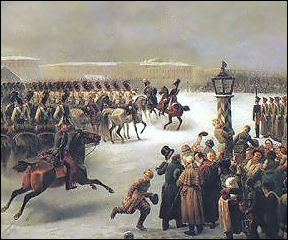
Decembrists One of the earliest Russian revolutionary groups, later called the Decembrist, launched a day-long revolt on December, 14, 1825 with the goal of overthrowing tsar Nicholas I. Hastily launched after Alexander I's death, the revolt was put down by tsarist troops who first tried peaceful methods and then opened firing with artillery, leaving behind dozens of dead and wounded in St. Petersburg's Senate square, where the revolt took place.
Many of the participants in the revolt were idealistic young aristocrats, who called for an end to the monarchy, freedom for serfs and the establishment of a constitutional government. Stirred by ideas of freedom and equality put forth by the American and French Revolutions, the rebels were noblemen, military officers, philosophers and poets. The average age of the ones arrested was 26.
Nicholas I, who had been in power less than a month before the Decembrist rebellion took place, and hadn't even been crowned yet, had been regarded as a potential reformer. He responded to the threat on his leadership, however, by setting the scene for a repressive 30-year reign with the establishment of a censorship system and establishing the Third Section, a secret police force that was a forerunner of the KGB.
Nicholas I saw the Decembrist uprising as a personal betrayal. Many of the participants were his close friends. After the leaders of the rebellion were hung, Nicholas said, "It is my duty to give a lesson to Russia" Nicholas I also led a campaign a against what he considered to be corrupting Western ideas. Ideas that aimed to give people more power and rights were suppressed.
Over 100 Decembrist men that were captured were sent to Siberian camps, where they survived with the help of their wives and lovers, who made the 4,000-mile, three-month journey to join them. These women, many of whom gave up lives of luxury for winters in peasant shacks in -40 degree temperatures, were credited with saving the lives of their men and they were referred to as "guardian angels." In Siberia, the Decembrist attempted to establish an ideal society in the prisons with their own garden plots and schools that offered courses in chemistry, geology, literature, economics, military strategy and ten languages.
Legacy of the Decembrists
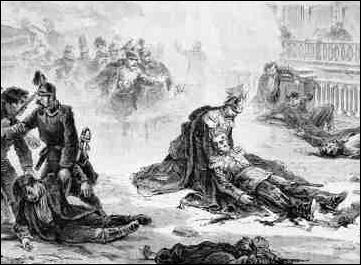
Assassination of Alexander II The Decembrists represented the first major cry of dissent and were an inspiration for Russian revolutionary movements, including the Bolsheviks, that followed them. Up to that point that tsars, for the most part, kept down the masses with enforced poverty and police persecution. But their harsh treatment of ordinary people created an environment for revolutionary activities because no other forms of dissent were available. Russians today still flock to Decembrist homes in Siberia, which during the Communist era were honored like pilgrimage shrines.
After Decembrist movement, officers and intellectuals in Russia formed secret societies whose aim was to bring down or change the tsarist government. Some groups looked to the West for inspirations. Others looked to the Orthodox church. Others still found hope in anarchy, chaos and village life. The spreading of the revolutionary movement was helped by writers and intellectuals like Turgenev and Tolstoy. Leo Tolstoy had planned to write a book about the Decembrists but wrote “War and Peace” instead.
The Decembrists movement also produced crackdowns on perceived dissent. Describing the atmosphere in St. Petersburg in the 1840s, French chronicler Marquis de Custine observed, when in "Petersburg, to lie is still to perform the part of a good citizen; to speak the truth, even in apparently unimportant matters, is to conspire. You would lose the favor of the emperor, if you were to observe that he had a cold in his head."
Alexander II Assassinated by an Anarchist Suicide Bomber
Alexander II In 1881, Russian tsar Alexander II was assassinated by the anarchist group Narodnaya Volya, who hoped to end Tsarist rule in Russia with their act. Alexander II was the target of several assassination attempts before that. He survived an attempt in 1879 in which two bombs where planted in tunnels underneath the tsars train route. One bomb failed to explode and the other derailed the train but failed to hurt anyone. In 1880, part of the Winter Palace was blown up.
In 1881, Alexander II was assassinated in St. Petersburg by a terrorist who strapped a bomb to his body and burst out of a crowd and blew up himself and the tsar, who was riding in a carriage. Narodnaya Volya — a secret society whose name means the People's Will — claimed responsibility for the murder which it had hoped would ignite a revolution. Instead anybody remotely connected to plot was rounded up and executed.
Commune of 1871
After the Franco-Prussian War, many Frenchmen were outraged by concession given to the Germans, namely the transfer of the capital from Paris to Versailles and the ceding of the iron-rich provinces of Alsace and Lorriane to the Germans. They were also angered by the take over of the government in Versailles by monarchists.
Parisians seceded from France and France was divided into two parts: the Third Republic, with the regular army, at Versailles and the Paris Commune, ruled by working people and the National Guard, in Paris. The Commune hoped to join with other French cities and create a French confederation. Members of the Commune were called Communards.
The Paris Commune, which was evolving into a Communist state, existed for only for two months. It came to an end in May 1871 when the regular army entered Paris, while Prussian soldiers looked on from their positions north of the city, and captured the city in a "bloody week" of barricades and street-to-street fighting. The Communards executed hostages, including the Archbishop of Paris and set fire to the city hall, the Palace of Justice, Tuileries palaces and other government buildings.
The Versailles government retaliated and executed an estimated 20,000 Communards and exiled 7,500 others. Reprisals continued until a general amnesty was offered in 1880. The uprising and fighting left Paris a blackened smoldering ruin.
Fighting at the Paris Commune
Describing the fighting in Paris May 23 after the regular French army entered Paris Archibald Forbes wrote, "The fighting is furious and confusing all around. At the Opera House it is especially strong. I see troops and man after man skulking along the parapets of its roof...The Federals are now massed at the top of Rue Lafite and firing down towards the boulevards. This must means the Versaillists are on the boulevard below....They were Versaillists that I saw on the parapet of the New Opera. There is a cheer; the people rush out into the fire and clap their hands. The tricolor is waving on the hither end of the Opera House."
Describing the fighting May 24, Forbes wrote, "The Versailles troops collected about the foot of Ruse Saint-Honoré were enjoying the fine game of Communist hunting." A man is pulled from a carriage. "They yell — the crowd — 'Shoot him; shoot him!'...The stick falls on the frail man in black...He is down; he is up again; he is down again the thuds of the gunstocks on him sounding...They are firing into the flaccid carcass now...His brains spur on my boot."
Describing what remained on May 29, Forbes wrote, "The ghastliest sight" was a hollow "now filled up with dead. One could measure the dead by the road. There they lay... each successive tier powdered over with a coating of chloride of lime...Among the dead were many women.
Anarchist Terrorism
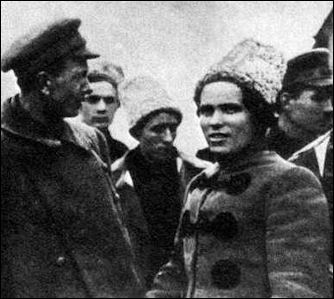
Makhno group anarchists The late 19th century saw a wave of political violence inspired by anarchist ideas which were labeled anarchist terrorism. Violent acts considered anarchic terrorism included: 1) the assassination of Russian Tsar Alexander II by Narodnaya Volya in 1881; 2) the assassination of the French president Marie-Francois Sadi Carnot and 3) the bombing of Greenwich Observatory in London in 1894; and 4) the assassination of American president William McKinley in September 1901, by an anarchist, Leon Czolgosz.
The assassinations listed above triggered fears among governments that an Al-Qaida-like international movement of anarchist terrorists existed but in reality such an organization nver existed. Anarchists themselves argued they were not terrorists. Such claims are backed up by the fact that most anarchists were are against the use of violence to achieve political aims, and violence by anarchists was historically directed at political figures, not civilians, as terrorism is.
On some parallels between the anarchist and modern terrorists, Rick Coolsaet, professor of International Relations at the University of Ghent in Belgium and author of a book on Al-Qaida, was quoted by about.com as saying: “Muslims are often regarded now with the same mixture of fear and contempt as workers were in the 19th century. And the jihadi terrorist has the same feelings about America as his anarchist predecessor had about the bourgeoisie: he sees it as the epitome of arrogance and power. Osama bin Laden is a 21st century Ravachol, a living symbol of hatred and resistance for his followers, a bogeyman for the police and intelligence services. Today’s jihadis resemble yesterday’s anarchists: in reality, a myriad of tiny groups; in their own eyes, a vanguard rallying the oppressed masses. Saudi Arabia has now taken the role of Italy while 11 September 2001 is the modern version of 24 June 1894, a wake-up call to the international community.
“The reasons for the rise of terrorism now and anarchism then are the same,” Coolsaet said. “Muslims worldwide are united by a sense of unease and crisis. The Arab world seems to be more bitter, more cynical and less creative than it was in the 1980s. There is a growing sense of solidarity with other Muslims, a feeling that Islam itself is in danger. This is fertile ground for a fanatical minority.”
Image Sources: Wikimedia Commons
Text Sources: New York Times, Washington Post, Los Angeles Times, Times of London, The Guardian, National Geographic, The New Yorker, Time, Newsweek, Reuters, AP, AFP, Wall Street Journal, The Atlantic Monthly, The Economist, Global Viewpoint (Christian Science Monitor), Foreign Policy, Wikipedia, BBC, CNN, NBC News, Fox News and various books and other publications.
Last updated July 2012

